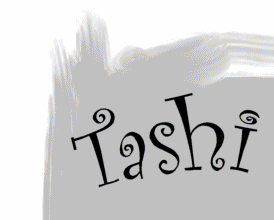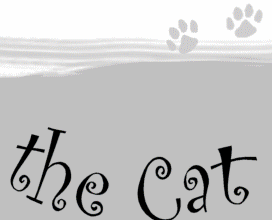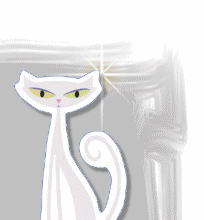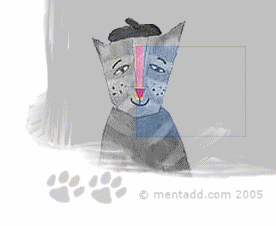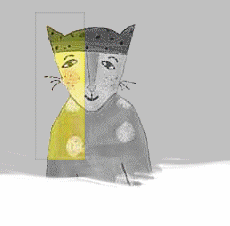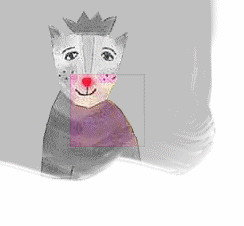Contact
To contact me, please go to my
Sims site and use the contact
link at the top of the page.
How I medicated the hardest to
medicate cat in North America
Tashi came to me at about 6 months old, a confirmed lover of
dry kibble type food, which isn't real useful for absorbing liquid medication or
masking it's heinous taste very well, but when I tried stirring her
medicine into a nice high-quality wet food, she turned her nose up at
it. I had to find another delivery method, and fast.
I had noticed that on earlier attempts
to switch her to quality wet food, she would lick all the liquid out and
then just leave the rest or least most of it for hours... longer than
I'd want refrigerated medicine to just sit around, put it that way.
This is an important key to success though - to notice things your cat
tends to do and work with those natural tendencies.
| |
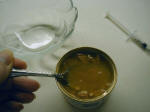 |
Here I'm pressing the back of a spoon
into a highly addictive lower quality canned food to extract the liquid.
This particular food is so highly addictive, I don't recommend it for
any other purpose than delivering medicines. Hint: It's a
really small can and it's especially designed for finicky cats. |
|
| |
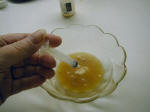 |
Here I've injected the dose of
medicine. Notice that I have NOT stirred it in. Stirring it
in only seems to make the entire thing taste terrible, so if you're cat
is turning it's nose up at medicine in food try to isolate the bad taste
by not stirring it in. |
|
| |
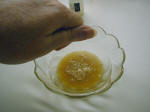 |
Here I'm crumbling a couple of soft
treats over the medicine. I've found that surrounding a small bad
taste with a lot of things your cat likes the taste of helps a lot.
Tashi is not a big nor eager eater so this was a significant finding for
me as I only have a small daily appetite to work with each day that I
have to make the most of. |
|
| |
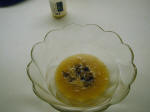 |
Here I've added a few
pieces of her favorite
dry kibble food to give a familiar smell to the mixture. Even when
Tashi must hit the concentrated medicine taste, the other good tastes
are so close by that surprisingly, she just keeps going right through
it. |
|
We went from 3 hour
ordeals to 3 minute walks in the park getting her meds into her system.
Heaven!
NOTE: Put the medicine
into the smallest amount of liquid from the can as you can get away with
as the richness of it can cause slight diarrhea, possible
gastrointestinal distress for your cat and most probably feline
flatulence!
After her morning medicine
I allow free access to the left over canned food and a bowl of her
favorite dry kibble food for a few hours. After that I put it on
the counter until after her evening dose of medicine. After her
evening dose, she has free access to foods until bedtime and then I put
it up on the counter again. Because she was underweight when I got
her from the shelter, she was used to free access to her food, but I
have found this slight restriction works well for us. If your cat
is not underweight, I don't recommend free access normally but after
medicine doses, it's a much deserved reward and gives her a chance to
eat what she pleases.
| WARNING: Litter that
can kill your cat! Clumping clay litter that contains sodium bentonite is extremely
dangerous for your felines as when ingested during normal grooming from
the paws, it forms hard clumps in their digestive tracts which can cause
anything from pain to death. If you're using a product that fits
this description and most especially if you have a long haired cat that
gets quite a bit of litter stuck to their fur, PLEASE STOP NOW!
|
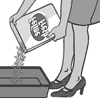 |
Besides the obvious health
concerns with the clumping agent, these kinds of litters have harmful
silica dust that your cat and you inhale that damages breathing surfaces
permanently and is also a known carcinogen. Several years before I
educated myself on this matter, I had a cat die from the effects of
clumping litter in her system and it was a slow and painful death that I
will feel guilty about for the rest of my life. As if all of that
wasn't bad enough, clay mines are not eco-friendly either. I
really have nothing good to say about clay litters, and most especially
about clumping clay litters. You can bet they're not great for
your plumbing either! Think about it.
My veterinarian
was NO help whatsoever with figuring out this problem, so don't expect yours to be! Don't put yourself through the guilt or your cat through the
pain.
What seems like common sense in hindsight was something nobody figured
out at the time, and so many cats are suffering needlessly while the
makers of these products count their blood money and insist their
customers are perfectly happy injuring and killing their beloved pets
with their convenient product.
Educate yourself and learn the TRUTH!
|
Alternatives
Try pine wood pellet or
corn cob litters. They're natural and safe as long as the pine
kind is only made from kiln-dried (natural oils-removed) pine sawdust
formed into pellets and the corn variety doesn't have any pesticide
residues on it.
|
 |
The shelter I got Tashi
from was using a pine wood litter so I got the same thing to ease her
transition and I'm so glad I did. It's amazing. There is NO
unpleasant scent whatsoever! Not right away and not two, three or
even four weeks later. After a month I change Tashi's litter, even
though I can literally pick up her litter box and sniff it and still
detect no scent at all. By then the pellets are mostly saw dust
and that's when it's time to replace them. I do remove solid waste
right away, and a little saw dust usually sticks to that, but it's
perfectly safe to flush small amounts of saw dust. When I dump out
the litter into a big green garbage bag, I place the pan in the tub and
pour boiling water all around the sides and into it and let it sit for a
while. Then I dump the water down the toilet and dry the pan with
a paper towel. Because I'm using soft wood instead of hard silica,
the pan stays in perfect non-scratched condition so it's easy to keep it
hygienic. It always looks brand new to be honest.
Pine litter is
environmentally friendly and 100% natural and safe to use. It's so
long lasting, controls odors perfectly and is affordable. It has
no dust during use or while cleaning and replacing for you or your cat
to inhale. It doesn't stick to your cat or track all over the
house. I never thought a litter would come along as perfect as
pine litter. Even the most finicky nose can not even detect it's
presence in the home and I dare you to say that about any other litter
product with a straight face!
If much-loved cats eating
grocery store food (don't get me started) and living indoors safe are
lucky, surely when you add this litter and a quality food only available
from your vet and custom prescribed for your cat to the mix, you've got
one of the luckiest cats in the world. Doesn't your cat deserve to
be that lucky?
Messing with the litter a cat is used to can be problematic,
so if you want to switch to pine litter, put an inch of it underneath a
layer of your current product without stirring and slowly reduce your
current product until nothing is left but the pine pellets. If
your cat has any setbacks, simply slow down the process. Keywords I dislike: clumping, silica,
pearls, crystals, bentonite. Keywords I like: natural,
biodegradable, flushable and/or compostable.
Another option would be to
toilet
train your cat. Some say it's not natural and no cat would
ever do such a thing willingly. NOT TRUE! When I was growing
up, we had a cat that taught himself to use the toilet, so don't let
someone with an agenda (or maybe just jealous?) tell you what's normal
and natural and what isn't. If your cat doesn't want to learn
toilet training, trust me, it won't. Cats do not humor us with
stupid pet tricks. They leave that sort of thing to dogs and
humans.
|
